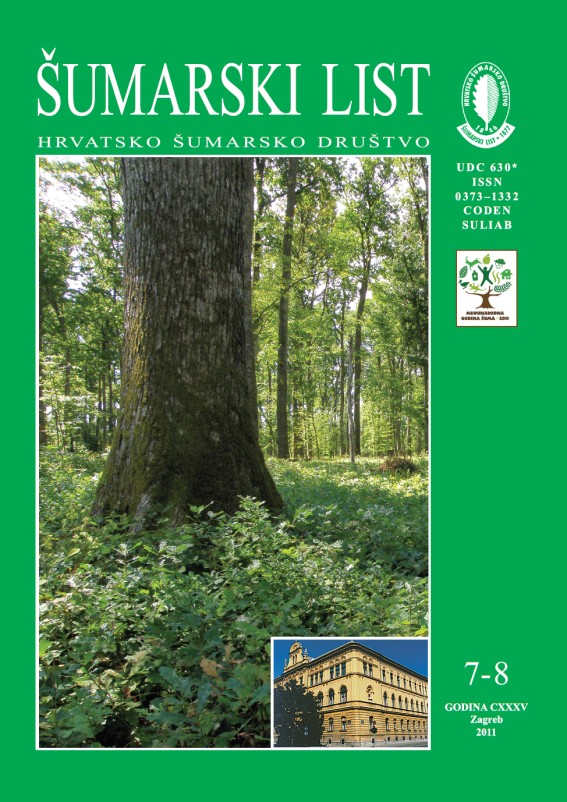
broj: 7-8/2011
pdf (5,9 MB) |
|
||||||||||||||
| RIJEČ UREDNIŠTVA | ||
| EDUCATION AND EMPLOYMENT pdf HR EN | 341 | |
| IZVORNI ZNANSTVENI ČLANCI | ||
| Jakovljević,T., M. Gradečki-Poštenjak, I. Radojčić Redovniković | UDK 630* 232.3 (Pinus pinea L.) (001) | |
| Physiological, Chemical andAntioxidant Properties of Fresh and Stored Stone Pine Seed (Pinus pinea L.) pdf HR EN | 343 | |
| Summary: The stone pine (Pinus pinea L.) is typically Mediterranean tree species found along the Mediterranean basin. In Croatia the stone pine is natively distributed on the island of Mljet, the locality Saplunara. The use of these seeds is extensive in the trade, the ecology, the landscape as well as in the nutrition. In the forestry it is used for the reforestation of degraded stands of the Mediterranean Karst region in Croatia. The umbrella shaped crown gives it very decorative form interesting in horticulture. The chemical composition is the reason for nutritive and health values. The seeds are rich in proteins, vitamins A, B, C, D and E, iron, magnesium, phosphorus, zinc, unsaturated fatty acids and polyphenols. In this research qualitative properties of seed (germination capacity, 1000 seed weight, moisture content), the chemical composition and antioxidant properties of seed coat and the seed (amount of total sulphur, total nitrogen and crude protein, phosphorus, potassium, calcium, magnesium, copper, zinc, iron, manganese and total polyphenols) were investigated. Physiological, chemical and antioxidant properties were investigated on fresh seed (3 provenances) and stored seed (1 provenance). Fresh seed was collected in 2009 and stored seed was collected in 1995 on the area of Forest Enterprise Split. The germination capacity was higher than the standard value. The provenance Mljet had low germination energy and the highest percentage of empty seed. The reason for this was the age of trees. The percentage of fresh ungerminated seed has shown seed dormancy, and the average was 9%. It was the type of mechanical dormancy. The provenance Dubrovnik had the highest percentage of fresh ungerminated seed. The seed health of all investigated provenance was good (Table 2). The average of germination capacity of stored seed provenance Zadar in the period from 1995 to 2010 was 74% (Table 3). Significant amount of nitrogen and sulphur gives the embryo the power to growth. The total amount of nitrogen, sulphur, crude protein and phosphorus was higher in the seed than in the seed coat. The high amount of crude protein shows that the stone pine seed is good source of proteins (Table 4). Stone pine seeds are rich in minerals, the most abundant element was potassium than phosphorus and magnesium. The other element abundance was as follows: calcium, iron, manganese, zinc and copper. Provenance Mljet (natural stand) had the highest amount of all investigated elements except phosphorus because it was an old stand (Table 5). There is no significant difference of mineral composition in the seed and in the seed coat. The amount of total polyphenols and the antioxidant capacity were investigated in the seed and in the seed coat. From the obtained results of total polyphenols it could be seen that seed from different provenances had different amount of polyphenols. The concentrations of total polyphenols were two times higher in the seed coat that in the seed (Figure 3). Antioxidant capacity i.e. ORAC values were significantly higher in the seed coat than in the seed (Figure 4). The linear correlation with high coefficient of determination was found between total polyphenols and antioxidant capacity (Figure 5). Total polyphenols are responsible for antioxidant activity. Research results are in good agreement with the reported values in other Mediterranean countries. The use of stone pine seed in Croatia is negligible therefore its production should be increased. Physical, physiological, nutritive and health properties of stone pine seed indicates that the foundation of multifunctional seed orchards would be necessary for seed production. Key words: antioxidant capacity; chemical composition; Pinus pineaL.; polyphenols; seed coat; seed quality; stone pine seed | ||
| PRETHODNO PRIOPĆENJE | ||
| Mihoci, I., M. Franjević | UDK 630* 453 | |
| Rare and Threatened Geometrid Moth Erannis ankeraria in Croatia: Historical Review, data Analysis & Perspectives pdf HR EN | 353 | |
| Kajba,D., J. Domac, V. Šegon | UDK 630* 537 + 238 | |
| Procjena potencijala brzorastućih nasada u Republici Hrvatskoj: Primjer razultata u sklopu FP7 projekta Biomass energy Europe pdf HR EN | 361 | |
| Kličić,H., S. Govorčin,T. Sinković, S. Gurda,T. Sedlar | UDK 630* 812 (Pinus sylvestris L.) | |
| Macroscopic Characteristics and Density of Scots Pine (Pinus Sylvestris L.) from Cazin, Bosnia and Herzegowina pdf HR EN | 371 | |
| STRUČNI ČLANCI | ||
| Barčić, D., N. Panić | UDK 630* 907 | |
| Ecological Valorisation of the ProtectedArea of “Kopački Rit” Nature Park pdf HR EN | 379 | |
| Mayer, Željko | UDK 630* 232 (Juglans nigra L.) | |
| Establishing Cultures of Black Walnut (Juglans nigra L.) by Generative Propagation pdf HR EN | 391 | |


